Chronology of the Ancient World Collection (6 vols.)
Digital Logos Edition
Overview
The Fasti Sacri, Fasti Romani, and Fasti Hellenici are extensive chronologies of the ancient world specializing on sacred and secular literature, civil events, and military actions of the Mediterranean world. Each military campaign, literary piece, natural disaster, or other major event in the Mediterranean world is chronicled and links to the original primary source documents that mention it. Additionally, numerous chapters discuss the history of chronology in the ancient world, explaining the Jewish calendar, the Julian calendar, and other ancient systems of dating and chronology.
Whether you’re interested in classical history or the chronology of the New Testament, the Chronology of the Ancient World Collection provides the source references you need. Every military campaign, literary masterpiece, or historical event is chronicled in tables spanning from BC 560–578 AD. References to ancient writers like Livy, Cicero, Josephus, and Dionysius support each historical event or publication, and link to the actual text in your library. Greek and Latin excerpts from the ancient writers can be looked up with just a click, and dates connect you to your Timeline for a bigger view of world history. Additionally, these resources will link to and from specific events on your Timeline, allowing you to navigate one of Logos Bible Software's best-loved features with ease and scholarly precision.
Key Features
- Connects to specific events on Logos Bible Software's Timeline
- References primary source documents from classical writers such as Livy and Josephus
- Provides thousands of pages of chronological history
- Explains ancient calendar systems and measurements of time
Product Details
- Title: Chronology of the Ancient World Collection
- Authors: Henry Fynes Clinton and Thomas Lewin
- Publishers: Oxford University Press and Longmans, Green, and Co.
- Volumes: 6
- Pages: 3,680
Individual Titles
- Fasti Sacri: A Key to the Chronology of the New Testament by Thomas Lewin
- Fasti Romani: The Civil and Literary Chronology of Rome and Constantinople, vol. 1 by Henry Fynes Clinton
- Fasti Romani: The Civil and Literary Chronology of Rome and Constantinople, vol. 2 by Henry Fynes Clinton
- Fasti Hellenici: The Civil and Literary Chronology of Greece, vol. 1 by Henry Fynes Clinton
- Fasti Hellenici: The Civil and Literary Chronology of Greece, vol. 2 by Henry Fynes Clinton
- Fasti Hellenici: The Civil and Literary Chronology of Greece, vol. 3 by Henry Fynes Clinton
This title is included in the following collections
You can save when you purchase this product as part of a collection.
2025 Messianic Jewish Platinum
$1,499.99$1,199.992025 Orthodox Platinum
$1,499.99$1,199.992025 Diamond Library
$2,999.99$2,249.992025 Preacher Diamond Library
$2,999.99$2,249.99
- $2,999.99$2,249.99
- $2,999.99$2,249.99
- $2,999.99$2,249.99
- $3,149.99$2,362.49
- $3,399.99$2,549.99
- $3,899.99$2,924.99
- $3,899.99$2,924.99
- $4,149.99$3,112.49
- $4,739.99$3,554.99
- $4,749.99$3,562.49
- $4,749.99$3,562.49
- $4,749.99$3,562.49
- $4,749.99$3,562.49
- $4,899.99$3,674.99
- $5,999.99$4,499.99
- $5,999.99$4,499.99
- $6,399.99$4,799.99
- $10,999.99$8,249.99
- $23,999.99$17,999.99
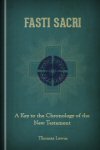
The Fasti Sacri is an enormous reference work providing chronological data on the events of the New Testament. With extensive notes and references to ancient historical works, as well as hundreds of pages’ worth of tables, charts, and graphs, the Fasti Sacri gives thorough explanation for dating any event of the New Testament. Extrabiblical sources are cited, including secular Jewish, Roman, and Greek authors and historians, and ancient calendars are explained in thorough depth, allowing the reader to compare Jewish or Roman calendar events against our standard calendar today. Eclipses and stellar phenomena are expounded using the best dating methods of the time, and indexes reveal the lines of Caesar and of Herod.
Contents
- Dissertation on the Chronology of the New Testament
- Chapter I: Date of the Death of Herod
- Chapter II: Date of the Nativity
- Chapter III: Date of the Crucifixion
- Chapter IV: Duration of Our Lord’s Ministry
- Chapter V: Date of Our Lord’s Baptism
- Chapter VI: Date of the Commencement of John the Baptist’s Ministry
- Chapter VII: Notes of Time to Be Found in the Gospels
- Chapter VIII: Date of St. Paul’s First Arrival at Corinth
- Chapter IX: Date of St. Paul’s Conversion
- Chapter X: Date of the Visit of Paul and Barnabas to Jerusalem
- Chapter XI: Date of St. Paul’s Visit to Jerusalem when He Was Arrested in the Temple
- Chapter XII: Date of St. Paul’s Release from Imprisonment at Rome
- Chronological Tables from B.C. 70 to A.D. 70
- Appendix
- The Jewish Year
- The Syro-Macedonian Year
- The Attic Year
- The Roman Calendar
- Parallel Years
- Table of Eclipses
- Cenotaphium Pisanum
- Monumentum Ancyranum
- Fasti Capitolini
- Stemma Caesarum
- Family of the Herods
- Index
- Errata and Addenda
Thomas Lewin, Esq., (1805–1877) was a scholar of history and social economics and a prolific writer. He also wrote The Life and Epistles of St. Paul, The Invasion of Britain by Julius Caesar, and The Siege of Jerusalem by Titus.
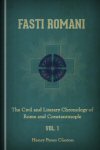
In two volumes, Henry F. Clinton’s Fasti Romani provides an important chronological history of the Roman Empire, establishing a high standard for chronological studies in classical history. Volume one contains the historical tables from AD 15–578 containing world events, publications, and the primary sources containing the accounts of those events.
Henry Fynes Clinton (1787–1852) was an English classical scholar and chronologist. He was educated at Westminster School and Christ Church, Oxford, where he studied classical literature and history.
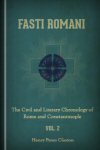
Fasti Romani: The Civil and Literary Chronology of Rome and Constantinople, vol. 2
- Author: Henry Fynes Clinton
- Publisher: Oxford University Press
- Publication Date: 1850
- Pages: 600
In two volumes, Henry F. Clinton’s Fasti Romani provides an important chronological history of the Roman Empire, establishing a high standard for chronological studies in classical history. Volume two is an extensive appendix containing genealogical tables, chronometrical systems, excerpts of primary sources, and essays analyzing .
Henry Fynes Clinton (1787–1852) was an English classical scholar and chronologist. He was educated at Westminster School and Christ Church, Oxford, where he studied classical literature and history.
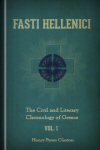
The Fasti Hellenici is a chronological view of the civil, military, and literary history of ancient Greece from the age of Pisistratus to the accession of Ptolemy Philadelphus. Only source documents are used in compiling this history, referring back to the authors and historians from within and after that time period who witnessed those events. The first two volumes covers BC 560–278, while the third volume covers BC 280–14 AD.
Henry Fynes Clinton (1787–1852) was an English classical scholar and chronologist. He was educated at Westminster School and Christ Church, Oxford, where he studied classical literature and history.
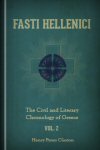
Fasti Hellenici: The Civil and Literary Chronology of Greece, vol. 2
- Author: Henry Fynes Clinton
- Publisher: Oxford University Press
- Publication Date: 1834
- Pages: 460
The Fasti Hellenici is a chronological view of the civil, military, and literary history of ancient Greece from the age of Pisistratus to the accession of Ptolemy Philadelphus. Only source documents are used in compiling this history, referring back to the authors and historians from within and after that time period who witnessed those events. The first two volumes covers BC 560–278, while the third volume covers BC 280–14 AD.
Henry Fynes Clinton (1787–1852) was an English classical scholar and chronologist. He was educated at Westminster School and Christ Church, Oxford, where he studied classical literature and history.
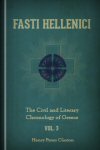
Fasti Hellenici: The Civil and Literary Chronology of Greece, vol. 3
- Author: Henry Fynes Clinton
- Publisher: Oxford University Press
- Publication Date: 1834
- Pages: 620
The Fasti Hellenici is a chronological view of the civil, military, and literary history of ancient Greece from the age of Pisistratus to the accession of Ptolemy Philadelphus. Only source documents are used in compiling this history, referring back to the authors and historians from within and after that time period who witnessed those events. The first two volumes covers BC 560–278, while the third volume covers BC 280–14 AD.
Henry Fynes Clinton (1787–1852) was an English classical scholar and chronologist. He was educated at Westminster School and Christ Church, Oxford, where he studied classical literature and history.